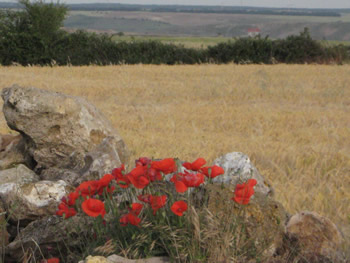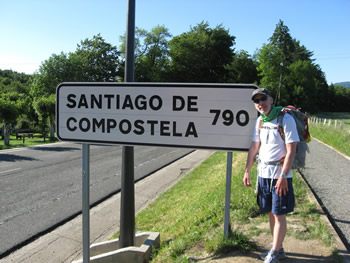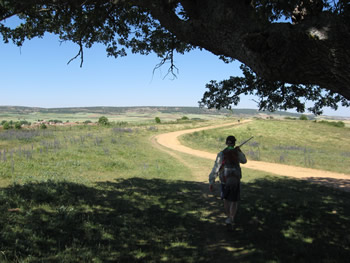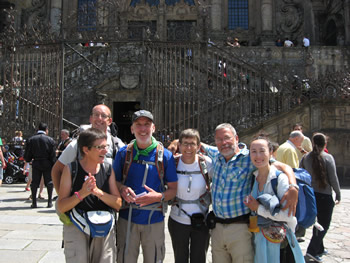A Deep Moment:
The Way of Saint James and the Words of Jesus
For Sunday August 12, 2012
Lectionary Readings (Revised Common Lectionary, Year B)
2 Samuel 18:5–9, 15, 31–33 or 1 Kings 19:4–8
Psalm 130 or Psalm 34:1–8
Ephesians 4:25–5:2
John 6:35, 41–51
Two weeks ago my wife and I finished walking the 500-mile El Camino de Santiago in northern Spain, following the footsteps of fellow Christians who've made this pilgrimage for over a thousand years. We began in the southwest corner of France, crossed the Pyrenees into Spain, then walked west for 33 days — one day for each year in the life of Christ. The camino ends at the Cathedral of St. James, a massive edifice with a history that began in 829 AD, and where legend says the bones of St. James are buried. If you are fortunate, this end signals a new beginning in your life.
Wildflowers on the way. |
Last year 180,000 pilgrims from 140 countries walked the Way of St. James. While it sounds crazy to walk 500 miles, many people did much more. Marie started in Le Puy, France, and so she walked 1,000 miles. Geraint from Wales began in Geneva, which meant 1200 miles. Helmut biked 1800 miles from Kiel, Germany. A couple a few days ahead of us left Holland in April and headed south. Many pilgrims had walked the camino more than once. Our flight attendant on the trip over had walked the camino three times, and warned us, "it's addictive!" She was right; I'd go again tomorrow.
The wild flowers were gorgeous. We loved leaving our normal routines at home for vigorous outdoor exercise in another culture. The architecture of the medieval churches, monasteries, and town squares made your jaw drop. But the best part about the pilgrimage were the people we met. On the plane home we jotted down the names of about 40 people from 30 countries with whom we had walked and talked for a few kilometers or a few days. Almost every conversation with these new friends began with two questions. Where are you from, and why are you walking?
Santiago 790 kms. |
Some people walk the camino just for fun. Bjorn and his twelve-year-old daughter Nora from Norway come to mind. But the majority of people we met were very clear that they were on a spiritual journey. As Americans, everyone asked us if we had seem the movie "The Way." I thought it was a mediocre movie, but now I realize that for many people it articulated the deepest longings of the human heart — life and death, love and friendship, work and play, and the meaning of a life well-lived.
Yusuru of Japan couldn't have weighed more than ninety pounds, and was easy to spot with her hot pink jacket, floppy hat, and umbrella. She said that she wasn't a Christian, but she ended every day by meditating in the quiet village churches and city cathedrals. Cho Hee from Korea was finishing four years of study in Finland and said that even though she was not religious, "of course the walk is a spiritual search." Ditto for a banker from Germany and a woman recently retired from the Paris stock market. Our friend Jean-Claude epitomized this common quest for a spiritual life that is fully and truly human.
Jean-Claude worked in the French steel industry, with responsibility for a $20 million budget and forty people. But working 60–70 hours a week had taken its toll. At the age of thirty-eight he was divorced, clinically-depressed, and badly overweight. "This is not living," he told us. So he quit his job, and in May started walking the Way of St. James in Le Puy, France. Two months and 1,000 miles later he had lost thirty-five pounds. We walked the last week of our camino with Jean-Claude, and on Wednesday, June 18, we entered the Cathedral of Santiago for the daily "pilgrim mass." Jean-Claude had never gone to church, nor had his parents, but that day was what another French friend called a "deep moment" for us all. Jean-Claude took the eucharist, and attended the pilgrim mass the next two days. He has a new job waiting for him in September, but he says that he doubts he'll take it; his dream is to open a pilgrim hostel in France.
Picture of the path. |
In Acts 17 Paul says that people are inherently religious. Every person, said St. Augustine, is created by God and for God, and so we remain restless until we find our rest in him.
We try to satisfy these deepest desires of human nature with many substitutes, some good and some bad — work and wealth, family or fame, sex and power. But the French mathematician Blaise Pascal compared our insatiable desires to a God-shaped vacuum which only one thing can fill: "What else does this craving, and this helplessness, proclaim but that there was once in us a true happiness, of which all that now remains is the empty print and trace? This we try in vain to fill with everything around us, seeking in things that are not there the help we cannot find in those that are, though none can help, since this infinite abyss can be filled only with an infinite and immutable object; in other words by God himself" (Pensees, 425).
Food sustains the physical body, and so in John 6 Jesus feeds the five thousand. But while food is necessary, by itself it's not sufficient for human life to flourish. We in the west have plenty to eat, and even an epidemic of obesity, and yet many people remain spiritually malnourished. And so Jesus points beyond the "sign" of literal food to the spiritual thing signified.
Group photo of the Cathedral of Santiago: http://en.wikipedia.org/wiki/Cathedral_of_Santiago_de_Compostela. |
Just as he compared himself to "living water" that quenches our thirst (John 4), he identifies himself as the one who satisfies our deepest hungers: "I am the bread of life. He who comes to me will never go hungry, and he who believes in me will never be thirsty" (6:35). The ancient Hebrews ate miraculous manna from heaven in the desert (Exodus 16), says Jesus, but they nevertheless died. Jesus, in contrast, says, "I am the living bread that came down from heaven. If a man eats of this bread, he will live forever. This bread is my flesh, which I will give for the life of the world" (6:51).
This story is one of the seven "I am" sayings in John, all of which are intentional literary allusions to God himself, who identified himself to Moses as "I am" (Exodus 3:14, John 8:58) In addition to the bread of life, Jesus compares himself to light in darkness (8:12), a gate to safe pasture (10:9), a good shepherd who sacrifices himself for his sheep (10:11), the resurrection and the life who conquers death (11:25), the way (14:6), and the true vine who fulfills Israel's destiny (15:1, Isaiah 5).
If this story scandalizes us today, we can at least console ourselves that it did the same thing to the original audience two thousand years ago. People grumbled about Jesus identifying himself with God; wasn't he just the son of Joseph, "whose father and mother we know? How can he say such things?" Even some of his own disciples dismissed Jesus's claim as a hard saying. "Who can accept this," they protested? From that time on, the gospel story concludes, "many of his disciples turned back and no longer followed him" (6:66).
Image credits: (1–4) Dan Clendenin.









